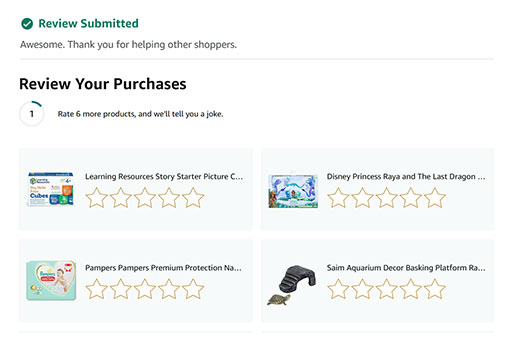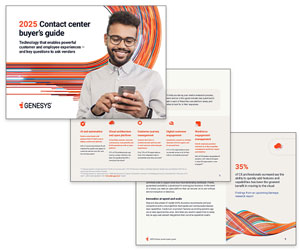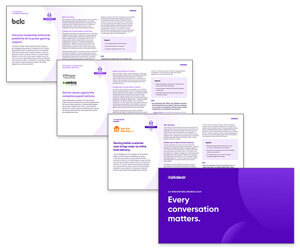Getting customers to share their feedback can often feel like pulling teeth! Whether it’s a quick online survey or a deeper, more thoughtful review, customers can be hesitant to speak up – either because they’re busy, don’t feel strongly about your product, or simply forget.
But as a contact centre leader, you know how valuable feedback is, providing crucial insights into customer satisfaction, areas for improvement, and ways to refine your products or services.
So, how do you get more customers to share their thoughts? The answer: ethical incentives. Offering creative, fun, or even monetary rewards can motivate your customers to take a few extra minutes to share their experiences. But there’s a fine line between a reward and a bribe for a perfect 10/10 score.
So, we’ve compiled a list of some of the best ways to incentivize customers to share their feedback ethically. Enjoy!
But First – What Are Ethical Incentives?
Ethical incentives are rewards or motivations that aim to foster participation without influencing the quality or honesty of the feedback given.
They do not promise or pressure customers into giving perfect scores or overly positive reviews. Instead, they reward the act of sharing genuine thoughts and experiences, regardless of whether the feedback is positive or negative.
Most ethical incentives are intrinsic (that is, driven by internal satisfaction), rather than extrinsic (performed solely or mostly for an external reason like money). While we will be covering some extrinsic options within this article, we’ll be adding a little note at the end of each section with suggestions as to how you can make it more ethical.
Ultimately, the goal is to create a win–win scenario where customers feel valued and appreciated while ensuring the integrity and authenticity of the feedback process.
Top 10 Ways to Encourage Customers to Share Their Feedback
1. Charity Donations
Some customers might appreciate the chance to give back rather than receiving a direct reward.
Offering to donate to a charity on behalf of customers who share their feedback can be a great way to motivate participation while making a positive impact in the community. For example, for every feedback submission, you could donate £1 to a charity your brand supports.
This type of incentive works particularly well if you’re targeting customers who are passionate about causes and social responsibility. Not only does it show that you value their time, but it also demonstrates that your business cares about giving back.
How to Make It Ethical
Make sure the donation is made regardless of whether the feedback is positive or negative, so customers don’t feel obligated to leave a glowing review for the sake of charity.
2. Exclusive Content
Everyone loves feeling like they’re getting something special. So, if you can create exclusive content or have the flexibility to offer early access to a sale, offer it to those customers who provide feedback.
This could be an exclusive online webinar, or a 24-hour head start on your latest sale – giving them a chance to snap up the best bargains as a thank you.
This kind of incentive not only encourages customers to share their opinions but also makes them feel like valued insiders. Plus, it builds anticipation and excitement around your products or services.
How to Make It Ethical
Avoid framing this as a reward for good feedback – instead say it’s “a thank you for their time”. This approach helps to ensure that customers feel comfortable investing their time in sharing their honest opinions – without worrying about losing out on perks.
You could even take a lighter approach with this and offer up a joke – as seen on Amazon:

3. Personalized Thank You Notes
Sometimes, a simple gesture of appreciation goes a long way. A heartfelt, handwritten thank you note (or a personalized email) can make a customer feel special.
If they feel like you’ve taken the time to acknowledge their feedback personally, they’re more likely to continue engaging with your brand in the future.
How to Make It Ethical
Acknowledge that the customer’s feedback is important to you, regardless of whether it’s positive or negative.
Also, mention specific aspects of their feedback, showing that you’ve taken it seriously and are considering their thoughts. This highlights your commitment to authentic engagement and continuous improvement.
If you want advice on how to write a great thank you note, read our article: How to Write a Thank You Letter to a Customer – With Examples
4. Early Access to New Features or Products
If you’re launching a new product, feature, or service, offer customers the chance to try it out before anyone else in exchange for their feedback.
Not only does this create excitement around your new offering, but it also makes customers feel like they’re part of something exclusive. They get to be the first to try the latest and greatest, and in return, you get their valuable input on how to improve it before it goes fully public.
This incentive can also extend to beta testing for apps, software, or websites – encouraging your customers to provide feedback while allowing them to shape the final product.
How to Make It Ethical
Emphasize that all customers who participate in providing feedback – whether positive or critical – will be given early access.
In fact, welcome notes for improvement and even frame your feedback form with boxes for both positive and negative comments.
After all, when trying to make a product or service the best that it can be, you don’t just want to hear from the people who sing your praises – you need those who aren’t afraid to speak out about what could be better in order to drive real improvement.
5. Gamification and League Tables
People love a challenge, especially when there’s a tangible reward at the end – so why not turn your feedback submission process into a game to make it more fun and engaging?
You could create a leaderboard where customers who leave feedback earn points, badges, or levels. Perhaps they can unlock a new reward every time they reach a certain number of points or feedback submissions?
You could even offer tiered rewards, so customers feel motivated to keep contributing. The more feedback they share, the better their reward – whether that’s access to special content, discounts, or entries into a bigger prize draw.
How to Make It Ethical
Make sure you have a quality screening process for weeding out anyone who might try to cheat the process – for example, submitting several one-word reviews to up their score – as, left unchecked, this could quickly compromise the integrity of the program and disincentivize people from taking part with genuine feedback.
Also, clearly communicate that customers can earn points for sharing any feedback, and the points are for the act of participating, not for providing a perfect score.
For more information on gamification and how it works, read our article: An Introduction to… Gamification
6. Monetary Rewards
While not always ideal for every business, offering a small monetary reward can be a highly effective incentive for gathering feedback.
This could be as simple as a £5 reward for completing a quick survey – issued in the form of a voucher or discount code. For higher-value items or services, this could be inflated to reflect the premium nature of the product and/or customer profile.
How to Make It Ethical
If you are essentially paying customers for their time, it should be done fairly and consistently – just as you would with any other employee.
So, try to align your rewards with the National Minimum Wage (at the very least!). For example, in the UK, National Minimum Wage is around £12 per hour – as of 1st April 2025, so you could offer a £4 reward for completing a 20-minute survey.
Adopting this approach will also help to keep monetary rewards consistent year-on-year depending on the amount of time you’re asking your customers to spend with you.
7. Thank You Gifts
A small, thoughtful gift can go a long way in showing customers that you value their input. This could be anything from branded merchandise, like a custom tote bag or coffee mug, to a free sample of another product you offer.
How to Make It Ethical
Be fair and transparent in your approach by making sure each gift is appropriately aligned with the time the customer has given you.
For example, someone who has completed their first 5-minute survey could qualify to receive a pen, whilst someone who has completed their fifth 20-minute survey could qualify for a hamper of treats.
Agree this scale of input vs. reward in advance and even publish it publicly on your website so customers can clearly see what’s in it for them. Also keep in mind that the gift should be a token of appreciation, not an exchange for a perfect review.
8. Discounts on Future Purchases
One of the most popular – and simple – ways to motivate customers is by offering a discount on their next purchase in exchange for their feedback.
This works well because it’s both a thank you and a future reward that can prompt customers to keep coming back. You could offer a specific percentage off, like 10%, or a fixed amount, like £5 off their next order.
How to Make It Ethical
It’s important to make sure the discount isn’t so large that it feels like you’re bribing customers for positive feedback.
For example, a 10% discount for filling out a feedback survey is reasonable and encourages participation without pushing the idea of only rewarding perfect scores.
9. Giveaways and Prize Draws
Sometimes the idea of winning something valuable can be all the incentive a customer needs.
Consider running a monthly or quarterly giveaway where customers who leave feedback are entered into a draw for a prize. It could be a product you sell, a gift card, or even an experience like a weekend getaway.
How to Make It Ethical
Avoid giving customers the impression that only favourable feedback increases their chances of winning.
State clearly that entries into the prize draw are based solely on submitting feedback, and all feedback, whether positive or negative, will be treated equally.
10. Loyalty Points
If you have a loyalty programme, this is a perfect way to get customers involved. Offer loyalty points in exchange for their feedback, which they can later redeem for products, discounts, or even exclusive experiences.
The great thing about loyalty points is that they create an ongoing relationship with customers and offer a more long-term incentive.
Loyalty points also allow for flexibility – you can reward the feedback in small increments based on the length or detail of the review.
For example, leaving a quick rating might earn 50 points, while providing a more detailed review could earn 200 points.
How to Make It Ethical
Ensure that the points are awarded only for the act of sharing feedback itself and for the amount of time they invest in sharing their thoughts – instead of for giving a 10/10 review. This will encourage more balanced and authentic feedback.
Earning a customer’s loyalty has many benefits. For ideas on how to do this, read our article: 7 Key Ideas for Winning Customer Loyalty
Are You Incentivizing Customer Feedback the Right Way?
Ethical incentives, whether they’re discounts, loyalty points, or exclusive content, should be about building a stronger connection with your audience, not about pushing for perfect scores or glowing reviews.
Keeping your incentives transparent, fair, and flexible will also attract more honest people and better-quality feedback – that can help you refine your products and services, improve customer satisfaction, and build a loyal base of customers who feel truly appreciated.
Never forget, the goal is to always create a culture of trust and transparency, where feedback is valued and rewarded regardless of its tone. This will not only lead to better insights but also cultivate long-term relationships that drive both growth and success.
If you are looking for more advice on collecting customer feedback, read these articles next:
- Want Your Frontline Staff to Share More Customer Feedback? Try This!
- Stop Spamming! 10 Better Ways to Collect Customer Feedback
- 11 Best Practices for a Voice of the Customer Survey
Author: Stephanie Lennox
Reviewed by: Megan Jones
Published On: 9th Apr 2025
Read more about - Customer Service Strategy, Customer Service, Customer Surveys, CX, Feedback, Stephanie Lennox, Top Story, Voice of the Customer




















